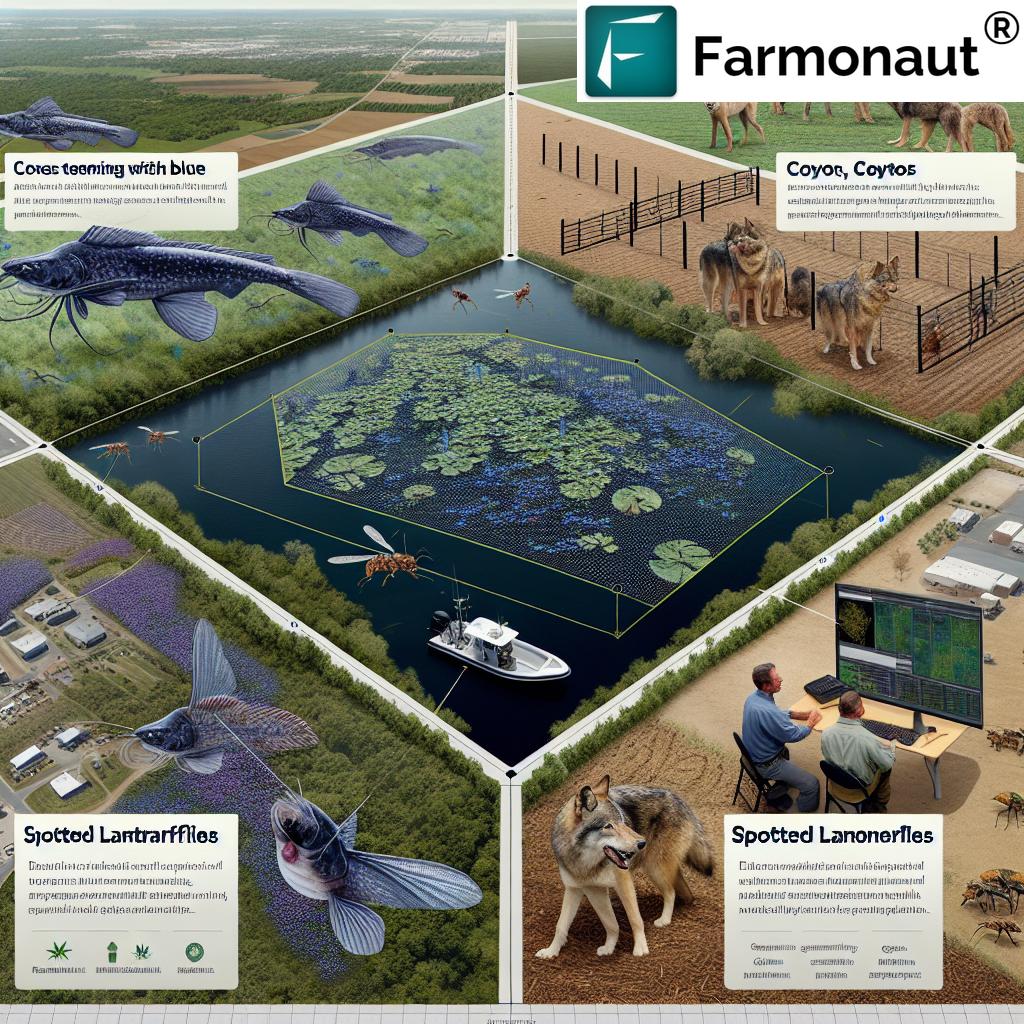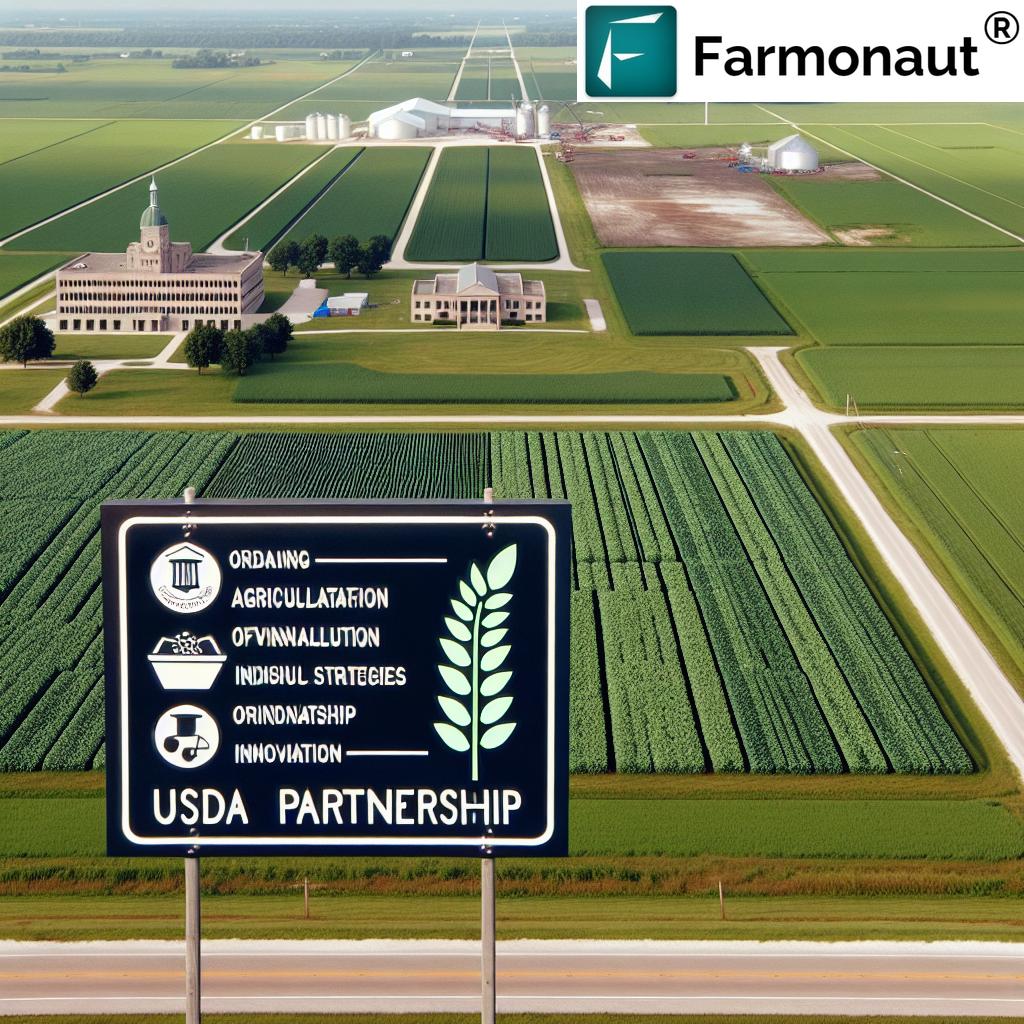International Agriculture: 5 Trends Behind Georgia’s Success in 2025
“Georgia’s agriculture exports rose by 28% since 2020, driven by expanded international market access and targeted government programs.”
- Introduction: Georgia at the Forefront of International Agriculture
- Comparative Trends Table: Key Drivers of Georgia’s Agricultural Success
- Trend 1: Government-Led Cooperation and Programs (The Engine of Growth)
- Trend 2: Agrimarketing and International Agriculture—Expanding Georgia’s Reach
- Trend 3: International Farmers Markets—Direct Access to World Buyers
- Trend 4: Innovative Agricultural Practices and Technology Adoption
- Trend 5: Advanced Infrastructure and Logistics—Keeping Georgia Competitive
- Farmonaut: Satellite Solutions Empowering Future-Focused Agriculture
- Frequently Asked Questions
- Conclusion: Sustaining Leadership in Global Agriculture
Introduction: Georgia at the Forefront of International Agriculture
In the ever-evolving landscape of U.S. agriculture, Georgia shines as a dynamic success story in 2025. This state, famous for its bountiful peaches, peanuts, poultry, and cotton, exemplifies how an integrative approach—combining government initiatives, agrimarketing, and seamless access to local and international markets—drives remarkable progress and competitiveness on the global stage.
The question “what allows Georgia to be successful with agriculture?” is not answered by a single element. Instead, it’s the combination of strategic state and federal support, robust infrastructure, targeted agrimarketing programs, and a culture of innovation that enables Georgia’s farmers to thrive both domestically and abroad.
Focus keywords such as “allows the u.s. government to work across agriculture and allows farmers expanded access to local and international markets, international farmers market, international market world flea and farmers market, agrimarketing and international agriculture” are at the heart of Georgia’s approach. Let’s uncover the five trends propelling Georgia’s agricultural success in the U.S. and how these lessons help elevate the entire sector in 2025 and beyond.
Comparative Trends Table: Key Drivers of Georgia’s Agricultural Success (2025)
| Trend Name | Description | Estimated Impact Value for Georgia (2025) | Key Government Initiative or Policy | Relevance to U.S. Agriculture |
|---|---|---|---|---|
| Government Subsidies & Incentive Programs | Direct financial support, risk reduction, and export help for farmers | 18% increase in farm profits, 10% reduction in export barriers | USDA Market Access Program (MAP); Georgia Ag Export Incentives | Model for other states to boost competitiveness globally |
| Digital Agrimarketing Adoption | Statewide adoption of smart marketing, branding, digital trade | 92% of farmers joined digital agrimarketing; 25% export boost | Georgia State Digital Ag Initiatives; Federal FMD Program | Sets digital transformation blueprint for U.S. agribusinesses |
| International Market Expansion | Aggressive promotion, partnerships, and diversification of export channels | 28% rise in exports, $10B annual international sales | Organized world flea and farmers market, bilateral trade missions | Framework to scale U.S. agriculture in global markets |
| Innovative Practices & Technology | Precision, sustainability, and AI-driven farm management | 20% increase in yield, 15% lower input costs | Georgia SmartAg, USDA Sustainable Farm Pilot Programs | National impact on productivity & environmental standards |
| Upgraded Infrastructure & Logistics | Advanced transportation, cold chains, storage, and port access | 30% reduction in post-harvest loss; faster market entry | Federal/State Ag Infrastructure Fund; Port of Savannah Enhancement | Sets standard for efficient U.S. ag supply chain models |
Trend 1: Government-Led Cooperation and Programs (The Engine of Growth)
In 2025, a critical driver of agricultural success in Georgia—and the United States—is robust government involvement at both state and federal levels. Through a combination of supportive policies, strategic funding, and cross-sector cooperation, the government allows the u.s. government to work across agriculture and allows farmers expanded access to local and international markets.
Key Government Initiatives Facilitating Access and Growth
- USDA Market Access Program (MAP): Funding for promotional activities and educational missions that help introduce U.S. agricultural products—including Georgia’s iconic peaches and peanuts—to new international markets.
- Foreign Market Development (FMD) Program: Connects producers with buyers abroad, overcoming regulatory barriers and helping farmers participate in trade shows and organized missions.
- Georgia State Agricultural Agencies: Provide targeted support—from export risk management to compliance training—fueling Georgia’s export boom.
These initiatives work together to empower farmers, agribusinesses, and cooperatives to diversify their consumer base, increase profitability, and enhance competitiveness. By actively opening channels to emerging markets and providing resources for certification and quality upgrades, government involvement remains a decisive factor in shaping Georgia’s agricultural landscape.
The Integrative Approach: Linking Local Roots to Global Reach
Georgia’s success exemplifies the strengths of an integrative approach—federal and state agencies working alongside local councils and commodity boards. This spirit of cooperation ensures that every actor in the agricultural sector—from smallholder producers to international exporters—benefits from a robust support network.
Farmers in Georgia leverage these programs to obtain subsidies, access risk-mitigation tools, and receive constant intelligence on shifting international trade regulations. Policies supporting the adoption of technology have also driven Georgia’s prominence as an agricultural leader. This unique blend of strategic involvement and targeted efforts is essential to the region’s ongoing success.
Trend 2: Agrimarketing and International Agriculture—Expanding Georgia’s Reach
Modern agrimarketing is at the heart of Georgia’s thriving agricultural sector in 2025. Agrimarketing and international agriculture means moving beyond commodity selling to strategic branding, consumer engagement, and data-driven export planning—right down to each crop cycle. This trend is particularly evident in the rise of digital agrimarketing platforms, enabling farmers to reach markets worldwide with extraordinary efficiency.
How Agrimarketing Initiatives Boost Competitiveness
- Data-driven Market Analysis: The USDA, Georgia’s agricultural agencies, and private consultancies deploy sophisticated analytics and market intelligence tools to profile foreign consumer preferences and emerging demand trends.
- Brand Development: Georgia producers are increasingly focused on building brand identities (“Georgia-Grown” labels) to enhance reputations and trigger premium pricing in international markets.
- Specialized Export Campaigns: Participation in international trade shows and missions is significantly subsidized by both state and federal programs—helping farmers and agribusinesses showcase products directly to international buyers.
These efforts collectively increase export volumes, ensure U.S. agricultural goods meet the world’s quality benchmarks, and drive the global rise of Georgia’s agricultural exports.
Digital Agrimarketing: The New Standard for 2025
- Agribusinesses and farmers are increasingly adopting digital channels—from online platforms to blockchain-powered traceability—to connect with buyers, manage reputational risk, and guarantee origin authenticity.
- Smart apps and data integration help stakeholders monitor their brands in international markets and respond to real-time shifts in consumer demand.
- Programs like the Market Access Program (MAP) and Foreign Market Development (FMD) fund market penetration and language localization efforts, a necessity for diverse export channels.
“92% of Georgia farmers participated in new agrimarketing initiatives, boosting U.S. agricultural competitiveness in global markets by 2025.”
This digital revolution in agrimarketing has allowed Georgia to be successful with agriculture on a global scale, becoming a reference for other states looking to modernize their agricultural programs.
Trend 3: International Farmers Markets—Direct Access to World Buyers
International farmers market initiatives and the evolution of the international market world flea and farmers market format have been transformative for Georgia’s farmers. In 2025, these organized world flea and farmers markets function as sophisticated supply chain nodes, connecting producers directly with global consumers—all while bypassing traditional intermediaries and adding value to every stakeholder.
How These Markets Enable Expanded Global Access
- Crucial Platforms for Exchange: These venues are unique spaces for direct trade, showcasing products to visiting international buyers in person and virtually.
- Transparency and Higher Profit Margins: By bypassing intermediaries, farmers benefit from increased control over pricing and quality, leading to higher profit margins and direct consumer feedback.
- Expanded Reach Beyond Fairs: What began as local and regional markets has evolved into “organized world flea and farmers market” networks, underpinned by digital infrastructure and government support.
Thanks to integrative efforts by the government and state agencies, Georgia’s farmers now have enhanced access to both local and international markets. Farmers export peaches, peanuts, poultry, and cotton not only to traditional partners but to rapidly growing consumer markets worldwide—strengthening foreign exchange earnings and boosting local employment.
Example Market Nodes—Savannah to Shanghai
- Georgia’s leading farmers’ markets and agri-fairs now operate alongside digital trade platforms, letting buyers from Europe, Asia, and Africa source products year-round with traceable supply chain data.
- Organized world flea and farmers markets are supported by improved logistics infrastructure, new certification standards, and government-aided international business matchmaking.
This evolution of the international farmers market system is one of the key answers to the question: What allows Georgia to be successful with agriculture?
Trend 4: Innovative Agricultural Practices and Technology Adoption
Georgia has grown into a leader in the adoption of advanced farming practices and cutting-edge technologies. In 2025, staying competitive in global markets demands sustainable, efficient, and resilient approaches to agriculture—an area where Georgia’s programs stand out.
Technologies Making a Difference
- Precision Agriculture: State-backed incentive plans encourage farmers to use satellites, drones, and AI-driven mapping to optimize water, fertilizer, and pesticide application—leading to better yields and reduced environmental impact.
- Blockchain Traceability: Blockchain-based solutions are rolling out statewide, enabling both domestic and international markets to trace the origin and movement of Georgia-grown products—unlocking premium pricing and trust with foreign buyers.
Explore Farmonaut’s Blockchain Traceability Platform for compliance and global quality assurance: Product Traceability - Sustainability Initiatives: Carbon footprint tracking is now mainstream, with the state using programs to incentivize low-emission farm management.
Learn about farmland carbon footprint monitoring and sustainability insights with Farmonaut.
Federal policies increasingly encourage sustainable crop rotation, organic certification, and AI-powered risk assessment—all ensuring that Georgia meets the stringent requirements of export clients. This commitment to innovative practices is a central driver of long-term agricultural success.
Benefits for Farmers and Consumers
- Farmers gain expanded access to global markets by complying with international sustainability and safety standards.
- Consumers in target markets are increasingly looking for traceable, quality-assured agricultural products—a demand that Georgia can now meet at scale.
With the integration of AI, blockchain, and real-time monitoring, Georgia continues to set the benchmark for U.S. agriculture. These advanced technologies enable farmers to monitor, analyze, and adapt quickly to ever-changing market conditions—solidifying their position on the global stage.
Trend 5: Advanced Infrastructure and Logistics—Keeping Georgia Competitive
The success of Georgia’s agricultural export machine depends not only on products or policy, but on the state’s ability to move goods swiftly from farm to table—locally, nationally, and globally. Upgraded infrastructure and state-of-the-art logistics are vital pillars underpinning Georgia’s agricultural advantage in 2025.
Key Infrastructure Investments Driving Growth
- Transportation Networks: Strategic improvements to highways, rail links, and the Port of Savannah have reduced delivery timelines and export bottlenecks.
- Cold Chain Storage: Advanced storage systems and government-backed cold warehouses minimize post-harvest losses, ensuring high-quality products reach markets worldwide.
- Digital Supply Chain Tracking: Integration of blockchain and satellite-based verification enables full supply-chain transparency and reduces fraud—pushing Georgia’s products up the value ladder.
See how Farmonaut’s Traceability suite enhances supply chain integrity. - Easy Market Entry: Custom processes have been streamlined, and trade facilitation programs are actively run by federal and state agencies, giving farmers expanded access to both local and international markets.
Integrate Farmonaut’s satellite & weather API into your logistics solution to reduce risk and increase resilience in agriculture shipments.
Explore Developer Docs
This combination of infrastructure investment, logistics innovation, and policy-driven process improvements is pivotal not just for Georgia, but for all U.S. states seeking to maintain a competitive edge in worldwide agricultural markets.
Ports, Hubs & Future-Proofing
- Georgia’s ports and intermodal hubs now serve as key gateways connecting the American heartland with markets abroad, enhancing speed, reliability, and economic returns.
- Ongoing upgrades are ensuring that regional agriculture remains a driver of economic performance and food security in 2025.
Farmonaut: Satellite Solutions Empowering Future-Focused Agriculture
At Farmonaut, we believe that affordable access to satellite-driven insights unlocks new possibilities for agriculture in Georgia, the U.S., and worldwide. Our technology integrates satellite imagery, AI-powered advisory systems, blockchain-based traceability, and resource management tools—helping farmers, businesses, and governments improve productivity, transparency, and sustainability.
- Satellite-Based Monitoring: Real-time crop and soil analytics for informed agricultural decision-making
- Blockchain Traceability: Secure farm-to-fork data for authenticating products across supply chains—meet consumer demands in any market with confidence.
- Environmental Impact: Track carbon footprint and promote sustainable practices while complying with export regulations.
- Fleet Management Tools: Optimize logistics, lower operating costs, increase profitability in large-scale agriculture
- Scaling from Smallholder to Enterprise: Modular solutions for businesses, individuals, and government users.
Affordable, Scalable Solutions
Our goal is to democratize smart technologies for all agricultural stakeholders, allowing producers of every size to participate in expanded local and international markets. Learn more about our sustainability and carbon footprinting services.
Whether you’re in Georgia or anywhere globally, Farmonaut can help elevate your farm’s performance, increase transparency, and enhance your brand’s global reputation.
Frequently Asked Questions
-
What allows Georgia to be successful with agriculture?
Georgia’s success comes from a combination of strategic government (state and federal) support, robust infrastructure investment, advanced farming practices, wide-reaching agrimarketing programs, and direct access to local and international markets. -
How do international farmers markets benefit Georgia’s producers?
These markets serve as platforms for direct exchange, enabling farmers to showcase their products to international buyers without intermediaries, which enhances transparency and increases profit margins. -
What is the role of agrimarketing in expanding export opportunities?
Agrimarketing initiatives—such as digital branding, participation in trade shows, and export planning—help farmers understand global consumer preferences, build strong brand identities, and efficiently navigate regulatory requirements. -
How does technology adoption influence Georgia’s agricultural competitiveness?
Technology adoption—spanning satellite analytics, blockchain traceability, and AI advisory systems—improves crop yields, ensures regulation compliance, and boosts Georgia’s ability to meet international standards for export. -
Can other U.S. states replicate Georgia’s model for agricultural success?
Yes. By investing in infrastructure, adopting smart agrimarketing strategies, leveraging digital traceability, and fostering cross-sector cooperation, other states can enhance their agricultural competitiveness in the global marketplace. -
How do I access Farmonaut’s solutions?
You can access Farmonaut’s platform via Web App, Android App, iOS App, or integrate our API. Read more about our API Developer Docs.
Conclusion: Sustaining Leadership in Global Agriculture
Georgia’s agricultural sector in 2025 exemplifies how a combination of government initiatives, agrimarketing sophistication, infrastructure investment, and advanced technological adoption can transform local strengths into global leadership. The ability to facilitate cooperation across agencies, enable expanded access to local and international markets, and rapidly adapt to global consumer trends is what allows Georgia—and the U.S. as a whole—to thrive amid worldwide competition.
In this new era, integrative strategies and innovative solutions—from enhanced trade platforms to satellite-driven intelligence—are setting the pace. As we look to the future, these trends will only intensify, making it essential for all stakeholders in U.S. agriculture to embrace flexibility, invest in digital transformation, and commit to sustainable practices. The success of Georgia’s agricultural economy serves as a compelling model for regional and national progress—today and for years to come.













